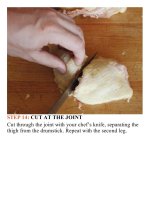The food lab better home cooking through science ( PDFDrive ) 1064
Bạn đang xem bản rút gọn của tài liệu. Xem và tải ngay bản đầy đủ của tài liệu tại đây (133.33 KB, 2 trang )
in a Dutch oven, you know that your range gets
splattered with little droplets of oil splashing out
from the sizzling food inside the pot. The sloping
sides of a wok, on the other hand, extend out a
good three inches or so from where the edges of
the oil are, catching those droplets and keeping
yourcounterneatandclean.
• It’s easier to maneuver .To get the crispest food
possible, it’s important to keep the food moving
(moreonthatbelow).Manytimes,youalsoneedto
flip foods while frying.The flared shape of a wok
makes it easy to reach in with a spider or
chopsticks,anditgivesyouplentyofroomtowork
in.
• There is less chance of a spill-over. Having a pot
ofhotoilbubbleovertherimofaDutchovenain’t
fun.It’sdangerous,theoilwillprobablycatchfire,
and, at the very least, it’ll make a huge mess. It
ranksuptherewiththeoldhand-in-the-blenderor
dog-in-the-dishwasher as worst kitchen nightmare
ever. It happens when you add too much moist or
cold food to a too-full pot of oil.The food rapidly
releasesbubblesofwatervapor,thosebubblespile
up on top of each other, and over the edges they
go. Since a wok widens out at the top, there is
much more volume for those bubbles to expand
into, so their surface area increases, weakening
their structure, and they pop before they get a
chancetogoupandover.
• It’s easier to keep the oil clean, making the
technique more economical.The edges of a Dutch
oven can harbor burnt bread crumbs, little bits of
French fries, and other such baddies. In a wok,
there’s no place to hide. Food particles left in hot
oil are the main reason the oil breaks down and
becomes unusable. Oil that’s carefully cleaned as
you cook should last for at least a dozen frying
sessions,ifnotmore.
THEKEYSTOPERFECTDEEPFRYING
Nomatterwhatcookingvesselyouchoose,herearetentips
toensurethatyourfryingwillbesuccessful:
UseaThermometer
There is no other way to ensure that your oil is at the right
temperature. Depending on what you’re cooking, you’ll
want to use different oil temperatures. For example, French
friesfriedat300°Fwillnevercrispup,andchickenfriedat
425°F will burn on the exterior before it’s cooked through.
A thermometer is the only way to guarantee that you’re
cooking things right.You can get a dedicated deep-frying
thermometer,butifyoualreadyownaThermapen(andyou
should!),it’lldothejobevenbetter.









